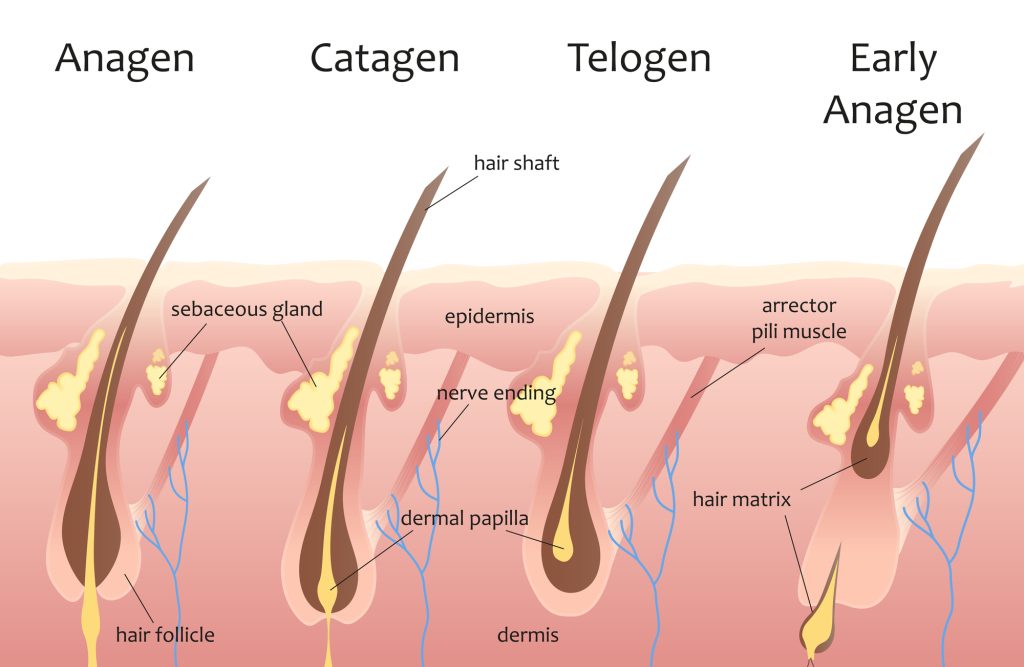
Not only is hair a characteristic that contributes to our overall physical appearance, but it is also an intricate and ever-changing component of our biology. A cycle comprised of several phases is involved in the hair growth process. It is essential to have an awareness of this cycle to comprehend both the natural process of hair loss and the treatments that are used to transplant hair. Within the scope of this blog article, we will delve into the complexities of the hair development cycle, examining how it affects hair loss as well as the scientific principles that underpin hair transplant therapies.
The Life Cycle of Hair Growth and The Anatomy of Hair Follicles
It may come as a surprise to hear that what you see as hair is dead tissue. Your hair, no matter how much care you put into washing, conditioning, and styling it, is completely inert. Tiny holes called hair follicles are located deep under the skin and are the source of hair. Imagine these follicles as little factories where a complex mixture of proteins, pigments, and hormones is churned out on an assembly line to produce hair. Nutrients for hair growth are supplied to each follicle via the blood arteries that bind them. If you’re thinking about getting a hair transplant, it helps to have a basic understanding of how a hair follicle works so you can grasp the intricacy of hair regeneration and restoration.
The three primary stages of the hair development cycle are the anagen, catagen, and telogen phases.
Anagen Phase
During the anagen phase, which is the active growth phase, hair cells divide at a rapid rate, and hair strands emerge from the follicles. As a result of this period, which might extend for several years, an individual’s hair will eventually reach its full length. The follicles are actively growing new hair at a rate of approximately 1 centimetre every month.
Catagen Phase
The catagen phase is a transitional phase that lasts for a few weeks and indicates that vigorous hair growth has brought a stop to the process. As a means of getting ready for the subsequent phase, the hair follicle contracts and the blood flow reduces.
Treatments that lengthen the Anagen phase and postpone entrance into Catagen, which preserve your locks for longer durations, require an understanding of this phase.
Telogen Phase
It is now winter, the telogen phase. During the three-month-long Telogen phase, your hair releases its growth hormone and falls out, preparing for the subsequent Anagen phase, when new hairs begin to emerge.
What Affects Cycles of Hair Growth?
Hair growth cycles are the result of a complicated interaction between a number of important variables rather than merely biology. Let’s examine this:
Genetics: The length of your hair growth stage and your susceptibility to diseases like pattern baldness can both be determined by your genetics. It’s all about the startling information you inherited from your ancestors.
Age: Our hair growth cycles change with every birthday cake. Grey or thinner hair is a result of the anagen, or growth phase, of hair growth slowing down and maybe shortening with age.
Hormones: Hormones have a major role in hair development. In particular, testosterone’s derivative DHT (dihydrotestosterone) can shorten anagen stages more quickly and reduce hair follicles.
Environmental Factors: Your environment and habits have an impact on the growth of your hair. Toxins in the environment, chemical treatments used frequently, and excessive heat style can all damage hair and interfere with the growth phase.
Acquiring Knowledge of Hair Loss

One of the most common concerns of many people is hair loss, which can be caused by many different circumstances. Hair loss is a natural part of the ageing process, and it can be caused by some factors, including genetics, hormone shifts, and lifestyle choices. Significant hair thinning can be the result of an imbalance in the hair development cycle, which occurs when a greater number of hairs enter the telogen phase and consequently shed.
Androgenetic alopecia, also known as male and female pattern baldness, is a genetic disorder that disrupts the normal hair growth patterns in both men and women. In the process of miniaturising hair follicles, hormones, and more notably dihydrotestosterone (DHT), play a crucial role. This process results in hair strands that are shorter and finer, and it continues until the follicle eventually stops producing new hair.
A Scientific Approach to Hair Transplantation Methods
Hair transplants are a treatment that is effective in restoring natural hair growth, and they are available to people who are looking for a cure for hair loss. Both follicular unit transplantation (FUT) and follicular unit extraction (FUE) are the approaches of hair transplantation that are utilised the most frequently.
The procedure known as Follicular Unit Transplantation (FUT) involves the removal of a strip of skin that contains hair follicles from the donor area, which is often the back of the head, and then transplanting it to the area of the scalp that is balding. This method makes it possible to perform the transplantation of a significant number of grafts in a single therapy session.
“Follicular Unit Extraction,” often known as “FUE,” is a technique that involves the individual removal of follicular units from the donor area and their subsequent implantation into the recipient site. This method results in minimum scarring and is appropriate for transplant procedures that are performed in fewer sessions.
By making use of the fact that hair follicles from the donor area are resistant to the effects of DHT, both FUT and FUE may help the transplanted hair will continue to grow naturally in its new place.
Knowing When to Do a Hair Transplant and How the Growth Cycle Works
The knowledge of the hair growth cycle becomes relevant at this point. When your hair grows is the most important factor in determining how well a hair transplant will take. If you want your transplanted hairs to look their finest, they should fall into phase with your natural Anagen. If you want the operation to be as effective as possible, it helps to know when your hair is growing.
Foreseen Features
The transplanted hairs follow a similar life cycle to their natural hairs, beginning with shedding as they adjust to their new home. This does not indicate a transplant failure; it is quite normal. After a year, you’ll see that these hairs are starting to grow in the same way as your real hair—in the Anagen phase.
Protection Following a Hair Transplant: Timely Care
Take special care of your just transplanted hair. Because the scalp can be delicate, you’ll get detailed instructions on how to clean and treat it. If you follow these steps, you should see better results and a speedier recovery.
Care for the Future
Transplanted hair, like your own hair, requires care in the long run. Medications, lotions, and speciality shampoos may be necessary to maintain healthy, strong hair. Its longevity is directly proportional to how well you maintain it.
Pick a Reputable Clinic for Your Hair Transplant
If you’re thinking about getting a hair transplant, you should look for a facility that uses cutting-edge equipment and staff members who are both caring and knowledgeable about the procedure. At GetHair, you will receive it.
A pioneer in the aesthetic, cosmetic, and skin treatment industries, GetHair has locations in the United Kingdom, Turkey, and the United States. Rest assured that you will be cared for by a team of highly skilled medical professionals at our clinics. Throughout your whole experience with GetHair, from the initial consultation to the aftercare, your comfort and the achievement of long-term results are our top priorities.
Depending on your preferences, we can use FUT, FUE or no-shave FUE methods. We can work with your hair’s natural growth cycle to get the best possible results because our state-of-the-art technology and expert doctors with ISHRS, ABHRS, and IAHRS certifications guarantee the utmost precision. We also provide a variety of maintenance treatments for following hair transplants to help you take the necessary steps to keep your new hair growing in as healthy a way as possible. You can contact us and get a free consultation if you have further questions.
Conclusion
It is essential to have a rudimentary understanding of the hair growth cycle to address issues regarding hair loss and begin exploring appropriate solutions such as hair transplants. There are now choices available to individuals to restore their natural hair, which not only offers cosmetic benefits but also provides a boost in confidence and self-esteem. These options have been made possible by advancements in medical technology. If you are thinking about getting a hair transplant, it is essential to discuss the procedure with a specialist who is both skilled and experienced to get the best possible outcomes. Individuals can make educated decisions that will improve their overall well-being provided they have the appropriate knowledge and competence. The journey to understanding and managing hair loss is a scientific one.
Sources:
Sinclair, R. (2015). Healthy Hair: What is it? Journal of Investigative Dermatology Symposium Proceedings, 17(1), 1–5.
Stenn, K. S., & Paus, R. (2001). Controls of Hair Follicle Cycling. Physiological Reviews, 81(1), 449–494.
Ohyama, M., & Veraitch, O. (2014). Strategies to enhance epithelial-mesenchymal
interactions for human hair follicle bioengineering. Journal of Dermatological Science, 73(2), 91–99.
Unger, W., Shapiro, R., & Unger, R. (2013). Advanced Trichology. CRC Press.
https://www.ncbi.nlm.nih.gov/pmc/articles/PMC10174680/

